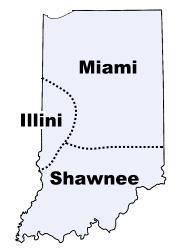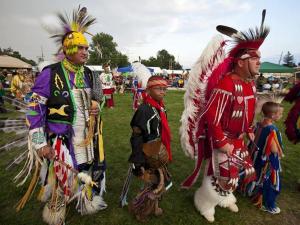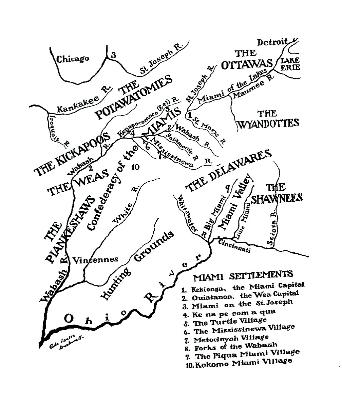Original Inhabitants Leave Legacy of Names
The Woodland Indian tribes of Miami, Potawatomi, Shawnee, Delaware and others who occupied present day Indiana have left us a legacy found as geographic names of villages, towns, cities, townships, counties, schools, parks, streets, streams and lakes. Today there are more than 100 Indian derived place names in Indiana. Madison County has been with such a legacy of names. A few are listed below and their origins.
ANDERSON
William Anderson, son of a Delaware woman and Swedish American trader, John Anderson, was born in a Delaware village along the Beaver Creek below Ft. Pitt, Pennsylvania, between 1750 and 1757. William Anderson's Delaware name was Kik-tha-we-nund meaning "make a cracking noise" or "causing to crack" such as a tree about to fall in the forest. In later years he became a chief and he and his people came west to Indiana. Several Delaware villages were situated along the Wapihanne or West Fork White River from Muncie to Noblesville. Anderson's Town or Wah-pi-mis-rink or Wapiminskink, meaning "place of the Chestnut Tree," was located on the South side of the White River near present day Anderson.
Fall Creek
The water falls at Pendleton, Indiana is the place of Fall Creek which also the name of the township. The Miami knew the falls and stream as chank-tun-onn-gi or "makes a noisy place." The Delaware name, sokpehllak translates as "spilt water." The early pioneers found it to be one of the best mill sites in the county.
Killbuck Creek
Killbuck Creek is named for the Delaware Indian chief Gelelemend Killbuck or Charles Henry Killbuck. Killbuck's village, Buckstown, was located about one mile northwest of Chesterfield on a high bluff over looking the White River. The chief was one of the Native Americans converted by the Moravian missionaries who had begun their work in the area in 1801. Chief Killbuck signed the Ft. Wayne Treaty of 1809 and the St. Mary's Treaty in 1818. Two tributaries of Killbuck Creek are both named Little Buck Creek.
Pipe Creek
Pipe Creek is named for the Delaware leader, Chief Pipe, who was also called Captain Pipe. His Delaware name was Tahunquecoppi meaning "Tobacco Pipe." His exact birth is unknown; however, he probably was born between 1725 and 1740. Little is known of his early years. In the spring of 1812, Chief Pipe and his people moved westward, locating near the present town of Orestes, Madison County, Indiana. It is said that Chief Pipe died around 1818 and is supposedly buried there. Other reports claim that he moved to Canada and died there. Captain Pipe had a son also named Captain Pipe who signed many treaties and moved with the Delaware people to Kansas in 1821.
White River
The West Fork of the White River was known to the Delaware as Wapihanne or "white waters." The sun exposed the gravel and sand bars were said to be a white sheen or luster. The Delaware had as many as 14 villages along the West Fork of the White River in central Indiana betweeen 1801-1821. The White River flowed westward past the Lenape villages of Munseetown, Buckstown(Killbuck's village), Andersontown(Wapiminskink), Nancytown(Nantikoke's Town), and Straw's Town before turning south and reaching the first white settlement in east central Indiana, the William Conner farm of 1802 where the Conner Prairie living history village is now located. The White River continues south, passing what would become Indianapolis.
Source: The Herald Bulletin
Author: Sheryl Hartman of Piankeshaw Trails Educational Park, Inc.
Most Native Americans were forced to leave Indiana during the Indian Removals of the 1800's. These tribes are not extinct, but except for the descendants of Indiana Indians who escaped from Removal, they do not live in Indiana anymore. They were moved to reservations in Kansas and Oklahoma.
Today remaining tribes in Indiana are active in the preservation of their cultures, history, and honor.
Madison County Historical Society|15 West 11th Street, P. O. Box 696, Anderson, Indiana 46015-0696|madisonchs10@gmail.com



